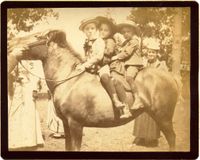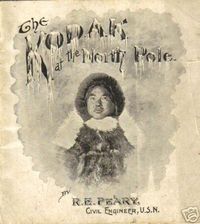No. 4 Kodak
This No. 4 is the biggest of the first series of Kodak cameras. The film holder can take spools for 48, 100 or 250 pictures of 4 x 5 inch (10 x 12,5 cm).
The film holder is located behind the plane of focus, as in all first generation Kodaks prior to 1895. Due to this construction the camera is rather long, about 12-3/4 inch (32 cm). It was quite a large box the photographer had to carry around.
The No. 4 Kodak was nevertheless a travelers camera, as s/he didn't need to change the 100 or 250 exposure film often. With these early cameras the photographer needed to find a dark room to change films, so the long strip of film was handy.
The camera was expensive, costing $ 50. For this you got the camera loaded with a 48 exposure film and a leather case. Only the more well to do could afford it. A farm laborer who earned $ 1.49 a day had to work 34 days for this amount of money.
It was made from November 1889 until 1897 and 4850 cameras were produced.
Taking photos with the No. 4 Kodak was simple. One only had to:
- pull the cord to cock the shutter
- turn the key to wind on the film
- set the distance
- aim the camera
- press the button.
If you wanted to eliminate every possible complication, you could choose a No. 2 Kodak, which had a fixed focus lens, so you didn't have to set the distance.
An interesting fact is that Arctic explorer Robert Peary used three No. 4 Kodaks on his early voyage to the north-east coast of Greenland during 1891-1892. He chose the No. 4 Kodak for its sturdy construction, ease of operation and 4 x 5 inch picture size. After the expedition one of the cameras was displayed on the 1893 Columbian Exposition. Today it is kept at the International Museum of Photography / George Eastman House in Rochester. Its serial number is 8283 and it is marked with the name 'Peary' and the letter 'B'. I have described all this, and much more about Peary's photography, in my articles "Kodaks op de Noordpool" in 'Photohistorisch tijdschrift' nr. 2 and 4 of 1997. An English translation was published as "Kodaks at the North Pole" in 'Photographica World' issue 100, of 2002. On my Articles page you can download them.

